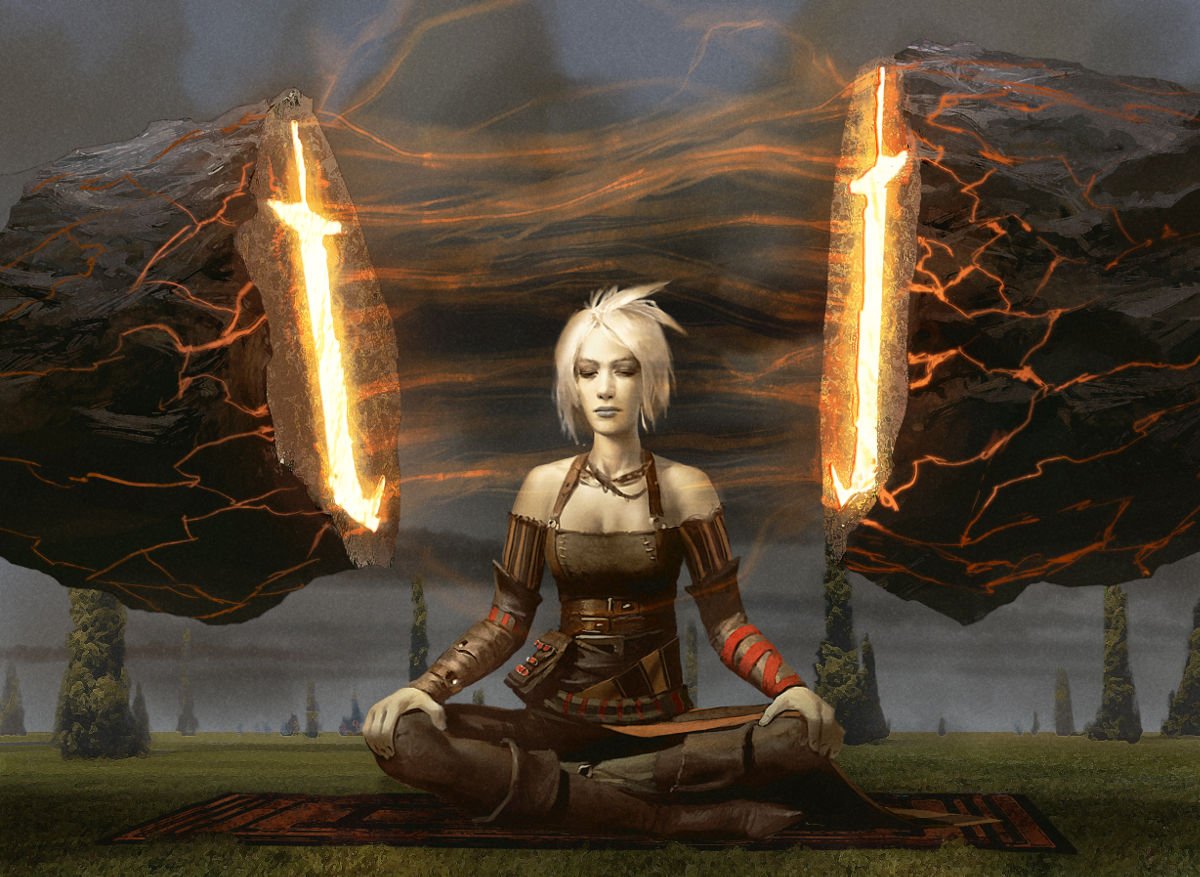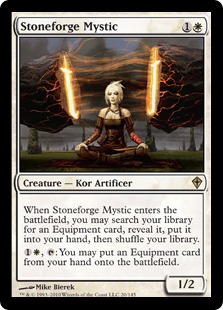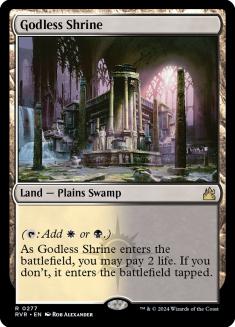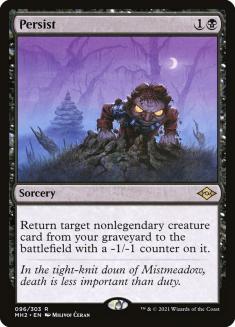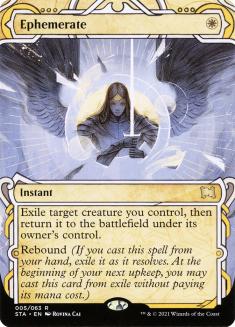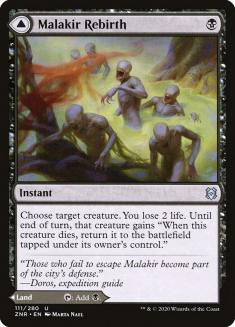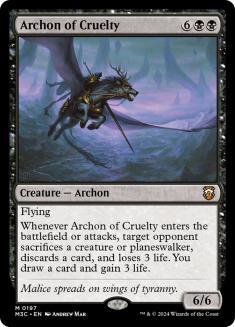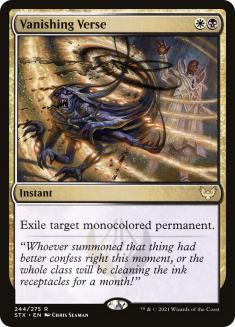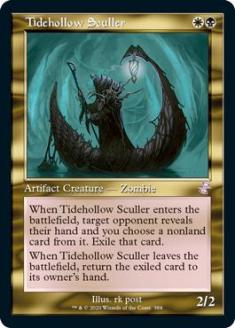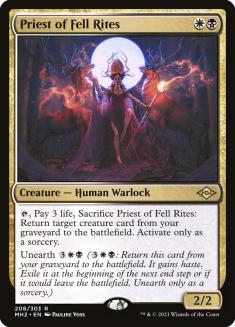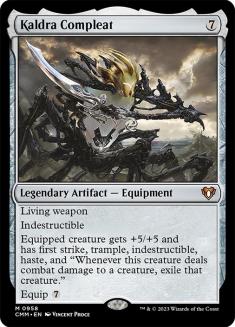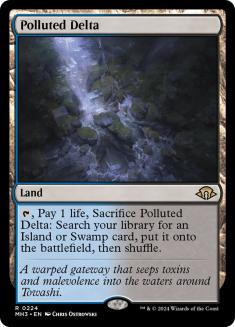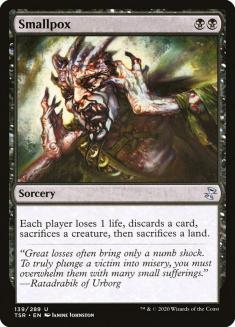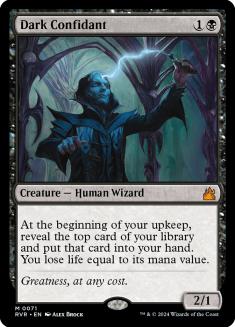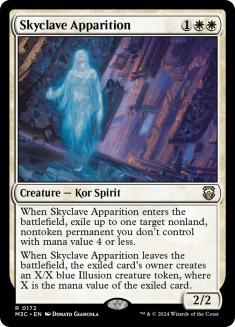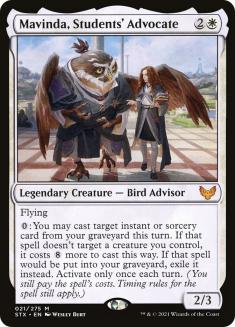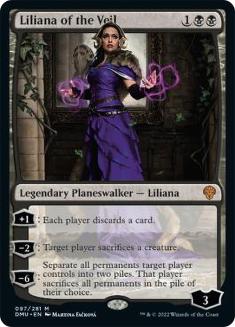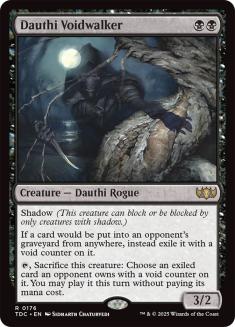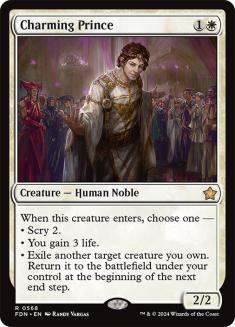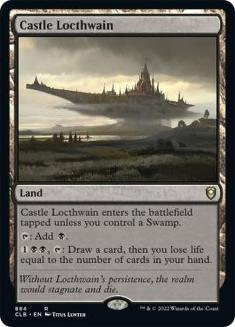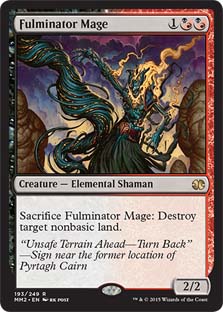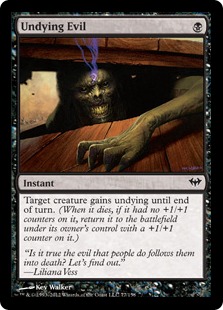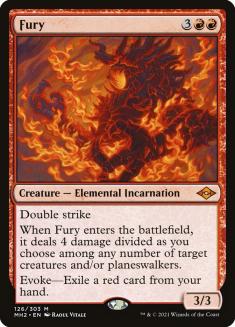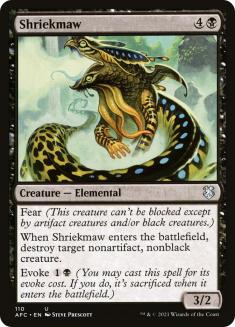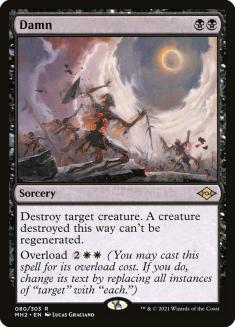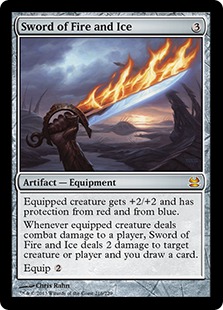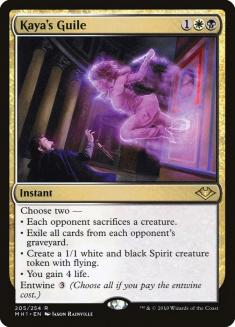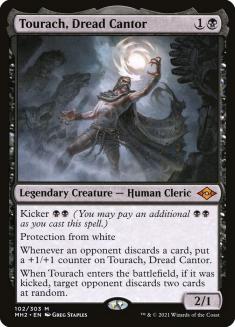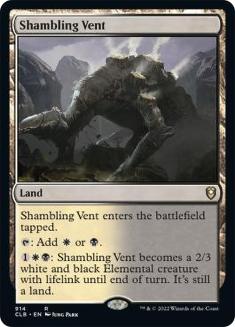Last week, Dom and I were tasked with the Herculean feat of reviewing all the Magic Online decklists from the Modern Horizons 2 rush: Leagues, Challenges, and Prelims. In those literally hundreds of lists, one weird thing stood out.
There was a ton of Orzhov Stoneforge Mystic decks. Like, almost an unreasonable number, and the only consistent cards across all the lists are Stoneforge Mystics, Equipment, and Orzhov lands. There were two options: either everyone really loves an otherwise derpy Orzhov pile, or there was some truth to be found amid the wide variety of options.
Fortunately for everyone reading, Cedric keeps me around to figure these things out for you.
A bit of a heads-up: I’m going to say cards are good in some lists, bad in others. Hopefully I provide enough context so that whatever Orzhov pile you make can figure out where that card falls given its specific cards.
Orzhov Stoneblade #1: Reanimator
One reason there was a ton of Ozhov decks was certainly the Grief-Ephemerate interaction. Something I called out as kinda awesome that people figured out this last week was using Persist as your Grief reuse mechanism. Persist is a super-powerful effect that suffers because there isn’t quite enough redundancy to let you go all-in Reanimator, and if you have a half-Reanimator deck you really want things to do with Persist when you don’t draw the full setup.
Creatures (18)
Lands (18)
Spells (24)

The first list I started with put the most into the Reanimator plan, to the point it was less Orzhov Stoneblade and more a Reanimator deck that accidentally played Stoneforge Mystic.
The Good:
The entire evoke Elemental Incarnation loop part of this deck was as good as it looked in preview season. Triggering Grief multiple times early is really similar to the double Thoughtseize plus threat draws from Jund Midrange or Death’s Shadow, but your mana commitment is even lower. It’s really easy to Turn 1 Grief, reuse it in some way, and jam right into some powerful two-drop and end the game.
The thing that wasn’t obvious in preview season that made this whole thing even more remarkable is how often just hard-casting Grief was good. Modern is just slower these days, and people tend to have relevant cards in their hand on Turn 4. Having a clean two-for-one threat like Grief is just good stuff.
I also want to specifically shout out Malakir Rebirth for being awesome. A black card that also is a Grief combo is the real deal. It’s not the actual card advantage of an Ephemerate, but I’ll take card parity where you spend three cards and one mana for double Thoughtseize and a 3/2 with menace.
Archon of Cruelty might not be Griselbrand, but it’s in the right ballpark. The spread of advantages it generates almost always ensures your opponent is crushed in some way and you stabilize to a good position. Against creature decks the lifegain and sacrifice carry you back most of the time, and against control the discard and draw mean they run out of resources while you get to set back up. It’s also a sweet one to protect with Ephemerate.
The Bad:
Vanishing Verse is not a good card right now after a new set of multicolor and artifact bombs. Get back to me when Heliod, Sun-Crowned is a big card again.
The entire upside of the Grief combo is mana efficiency and following it up with a game-ending play. Pairing it with Tidehollow Sculler, a two-drop discard spell, makes no sense even if Sculler is good with Ephemerate.
Persist is a really great card, but Priest of Fell Rites is not. Leaving yourself open to creature removal, bad. Waiting a turn, also bad. The unearth ability is comically expensive, even if you get to Unmarked Grave for the card. If this is what is required to play a Reanimator deck in this format, count me out.
I did say Archon of Cruelty was great, but the Reanimator plan here was not good. It may be a list-specific thing, since the big issue I kept running into was getting into sideboard games and not at all being configured to beat graveyard interaction. I wanted a way to shift my deck after sideboarding to something less graveyard-centric, but once you have Unmarked Grave you just have too many cards to swap.
Maybe if Unmarked Grave had a decent value target things would be different, but the graveyard value in this list is entirely in two-card setups. I did a quick search of flashback cards and there wasn’t really a good Entomb target, and I’m not really into Bloodghast or Lingering Souls since they seem low-impact. If you have any thoughts, I’m ready to hear them on Twitter.
This is not the right list for Kaldra Compleat. The point of that uncastable Stoneforge Mystic target is to maximize your single-card power in uninteractive matchups, but between your Grief combos and the Reanimator main plan, this list was not lacking in raw-power options. It did have “dead cards in hand” issues, and Kaldra Compleat being a colorless card was a big problem. Stoneforge Mystic here is just getting some good simple value, and I would either play double Batterskull or cut Stoneforge for some other efficient threat.
This was way too many fetchlands and not enough fetchables. This deck wasn’t getting any value from its lands, taking a bunch of damage, and running out of lands in weird spots against Field of Ruin or similar cards.
Final Grade: C-
There’s probably something to a heavy Reanimator deck with Grief interactions, but this isn’t it. I won a lot of games with the deck, but even marginal graveyard interaction like Territorial Kavu was a pain.
Orzhov Stoneblade #2 – Smallpox
Creatures (16)
- 3 Dark Confidant
- 3 Stoneforge Mystic
- 1 Mavinda, Students' Advocate
- 4 Grief
- 3 Solitude
- 2 Archon of Cruelty
Planeswalkers (3)
Lands (20)
Spells (21)

Taking a single step in the fair direction, we have this deck. There’s a bit of Reanimator, but more traditional Orzhov attrition stuff.
The Good:
Smallpox is a good card. It was somehow even good in this deck with a bunch of creatures, which doesn’t make a ton of sense. It’s pretty easy to sequence it before your creatures here, or exile it to Grief if that’s the way the game is going. It gives you another attrition “nut draw” where the only requirement is your opponent casting something into your Smallpox.
Side note: Vindicate wasn’t a top performer here, but I didn’t mind having it in the deck in small quantities. Once you have Smallpox in your deck, you should frame Vindicate as Pillage with upside though. Seriously, think about it. Pillage sees regular Modern play in 2021; Maelstrom Pulse has been trash for years. You want your Vindicates to approximate the better card, right?
What shocked me even more was how good Dark Confidant was. It’s just the exact thing you want to layer onto a Grief start after you strip away any plans your opponent had. I had definitely missed playing with good old Bob and I’m glad his prospects are looking up.
Skyclave Apparition was the sideboard card the previous Reanimator deck needed. There are too many things your opponent can do to graveyard-hate your plans, so you just want the broadest answer that’s also castable if they don’t do anything. Apparition covers all the normal hate permanents and also just exiles creatures if they don’t have Soul-Guide Lantern.
The Bad:
I don’t think you can run the full Reanimator plan without Unmarked Grave. Hoping to naturally draw your minimal copies of Archon of Cruelty with your Persists and your minimal discard outlets just doesn’t work. Land destruction as your secondary broken plan was just fine; no need to hybridize a low-odds third plan into all of that.
Mavinda, Students’ Advocate is not a relevant card here. The “recast Ephemerate, it rebounds to exile and recasts over and over” thing is cute but not good or necessary.
I don’t love the mix of Smallpox and three-drops. Liliana of the Veil was especially exposed to this issue since you would often run out two black sources early, sacrifice one to Smallpox, and then run the risk of drawing multiple Plains or Flagstones of Trokair as your follow-up sources.
Dauthi Voidwalker is a really bad actual piece of graveyard hate. I thought it would be sweet against Living End because of the self-sacrifice interacting with Living End well, but in practice it came down, immediately died to Living End, and did nothing against all their previous cycling actions. It’s not even a good fair card. Dauthi Voidwalker is probably the best graveyard hate card against something like Hardened Scales, where it’s just nice to have a hate card but not critical, and that isn’t how to spend your sideboard slots.
Final Grade: B-
I was pretty into this shell, and I think the most iterated version of it would be the one I most enjoy from the view of overlapping having fun and winning.
Before you ask, yes, I’m a terrible person who has large amounts of fun when my opponent used to control permanents.
Orzhov Stoneblade #3 – Oops All Flickers
Creatures (24)
- 1 Shriekmaw
- 2 Flickerwisp
- 4 Stoneforge Mystic
- 1 Murderous Rider
- 4 Charming Prince
- 4 Skyclave Apparition
- 4 Grief
- 4 Solitude
Lands (20)
Spells (16)

The next stop was the list with the best finish in a Challenge. Anyone can 5-0 a League if they play enough games, but Challenges are infrequent enough that the luck is more isolated. This list can best be described as all-in blinks, maximizing Grief and Solitude starts.
The Good:
I don’t think I’ve ever cast a Charming Prince I liked before playing this deck. One of the better follow-ups to Turn 1 Grief is just getting another Grief trigger while doing something, and Charming Prince qualifies as something. The scry mode of Charming Prince was also more relevant in this deck aimed at setting up lower-resource games with somewhat specific cards, and I often didn’t mind cashing in an extra Ephemerate for a couple of triggers.
On that low-resource game note, Castle Locthwain did some good work. All of these decks should probably play one or even two.
Fulminator Mage was a real sideboard all-star since it could be used to leverage your Undying Evils and similar cards. There was a similar effect to Snapcaster Mage letting you reuse your best sideboard instants, except the thing you were reusing was nuking a land, which is just good in a lot more scenarios when repeated. I would definitely consider this card for the Smallpox variants, even if I don’t love three-drops with Smallpox.
The Bad:
There was a bit of a dam-bursting moment playing this deck. Undying Evil was fine. Persist was fine. Even Ephemerate was just fine, since you rarely need triple of either Incarnation. There isn’t a big difference between any of them besides Malakir Rebirth which can be a land.
I haven’t gone down this road, and Solitude is really good so it’s hard to break the pattern, but I think the big lesson here is that you don’t need to play Orzhov for your Grief deck to do some cool stuff. There could easily be a Rakdos deck with Fury, Asmoranomardicadaistinaculdacar, Persist, Grief, and whatever else sounds good that does the same thing.
Shriekmaw is not a good card. The evoke plus rebuy thing is so much worse when it costs mana, and Shriekmaw doesn’t kill so many things. Construct tokens, Asmoranomardicadaistinaculdacar, it’s just not a good removal spell.
And I don’t even think Fatal Push is a good removal spell now either. It’s fine and always does a little bit against everyone, but if I’m sideboarding a removal spell I want something that does a better job. I did try a bit of Prismatic Ending and that wasn’t the trick either, so I think the real answer is just play all the Solitudes and Skyclave Apparitions you can and let the rest sort itself out.
Final Grade: C
This deck was fine and did a thing well, but it lacked depth. I lost multiple matches to things I just knew I couldn’t handle because the deck did nothing exciting when Grief and Solitude weren’t involved.
Orzhov Stoneblade #4 – Just Stones and Blades
Creatures (10)
Planeswalkers (3)
Lands (23)
Spells (25)

It can’t be all Grief. When I said Orzhov Stoneblade, I meant Orzhov Stoneblade, and I’m here for the full immersive Stoneblade experience. If there wasn’t a Lingering Souls in a deck today, did I really do good research?
The Good:
Damn is a really good card, and this deck is a perfect fit for it. There is zero chance an Orzhov Stoneblade deck would ever start Wrath of God, or even play many of them. But they would play Terminate, and they sure would love to draw Wrath of God sometimes. Damn is just a reasonable card that 30% of the time just completely dominates the game without extra opportunity cost to drawing it.
Unlike the Grief decks, this deck is all fair stuff all day and needs the power cap on Stoneforge Mystic to be raised to the Kaldra level. Sword of Fire and Ice also did good work, largely because drawing cards is good here.
Just don’t run your Kaldra Compleat into Archmage’s Charm. Batterskull has the built-in mechanism of bouncing itself if they steal the Germ token; not so much with the indestructible 5/5.
Even if Modern has become significantly more powerful with Modern Horizons 2, it didn’t get much more punishing of mana usage. Kaya’s Guile remains the champion of three-drop removal spells because it does everything.
I wouldn’t say it was good here, but on a similar note of getting free Game 1 coverage, Dauthi Voidwalker was much better here. It wasn’t a sideboard graveyard hate card you were leaning on, but getting some free percentage from a card you don’t mind playing already is great stuff.
Liliana of the Veil was much better here, in a deck that is better-suited to protecting her and better-suited to controlling three lands. She’s still a fairly strong card, and this deck does a good job of engineering the “they control one creature and are running low on cards” scenarios where she does her best work.
The Bad:
That all said about Liliana, she’s not lights-out in matchups like she used to be. Playing against Rakdos Death’s Shadow (Lurrus) was the eye-opener here, where they have Ragavan, Nimble Pilferer and Dragon’s Rage Channeler adding to their creature count and lowering their curve. While this deck is good at maneuvering to the optimal Liliana scenario, it isn’t a freeroll like it used to be. Her floor in those scenarios is still a Cruel Edict that gains life like Kaya’s Guile, but you need to accept that floor more often. She’s not a premium card driving you to play the deck, just a solid card with the chance to take over a game.
Tourach, Dread Cantor does basically nothing for two mana. It isn’t terrible as a four-drop for the same reasons Grief wasn’t, but when the fallback option for Grief is the ceiling on a card, I’m off it.
You know they make lands that produce significant value these days that don’t enter the battlefield tapped, right?
Final Grade: B-
While this deck felt like the most refined build of the set, that’s probably just because it’s easier to make a reasonably effective midrange pile than it is to tune a Grief deck. The cards weren’t bad and the deck has the scoreboard in its favor, but I do struggle to convince myself the Rakdos Death’s Shadow (Lurrus) decks aren’t doing a better version of the same thing.
Closing Thoughts
After playing with all the different Orzhov Stoneblade decks, I definitely understand why there are so many of them. Each of these decks did its own unique thing with cards the other decks weren’t that interested in using, and each of those unique things was pretty good. While they were all still in the realm of “fair midrange” in Modern, they did a better job of covering the metagame spread than I expected.
But as expected from early lists, each of these was a couple of cards off. I make no promises that’s a fixable issue for all of them, but if you love your Godless Shrines, it’s certainly worth the effort to put some work into each of these options.

